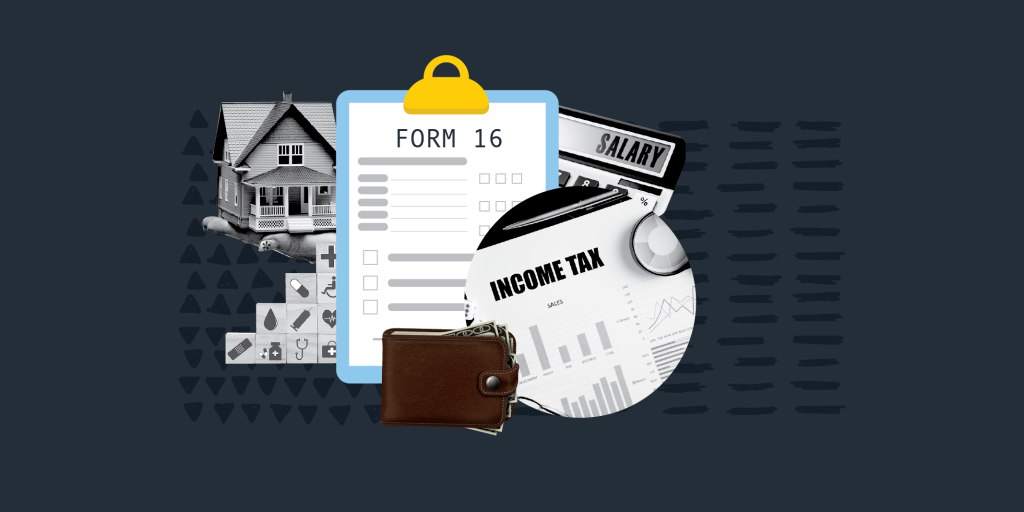Last Updated on Apr 6, 2021 by Manonmayi
The deadline to file your income tax return for the Financial Year 2019-20 and Assessment Year 2020-21 is postponed to 30th Nov 2020. And if you are a salaried individual, sorting out Form 16 is a must before filing your returns. In this article, let us look at what Form 16 is and why it’s important to collect yours from your employer.
The article covers:
Components of the salary certificate
Details from Form 16 required to file ITR
Table of Contents
What is Form 16?
Form 16 is issued under Section 203 of the Income Tax Act, 1961 by an employer to their employee for tax deducted at source (TDS) from the latter’s salary income. It is the summary of the amount paid/credited to the employee and taxes deducted thereon.
Significance of Form 16
Form 16 serves the following purposes:
- Since Form 16 has your TDS details for a financial year, it is an important source of information when filing your income tax return (ITR)
- Form 16 is proof of TDS deduction on salary from your income and is an important document for tax compliance
- You can furnish this form as proof during any income tax-related scrutiny
- Some organizations require you to submit Form 16 from your previous employer as part of the onboarding process
- Banks and other financial institutions accept Form 16 as a valid proof of income, which is crucial to get approval on loans
- In case you are to travel abroad, certain visa checklists require you to submit Form 16
When is Form 16 issued?
As per the current guidelines, an employer is required to issue Form 16 annually on or before 15th Jun of the year following the financial year in which TDS was deducted. In case there was no tax deducted at source in a given year, the employer will not issue Form 16 for that year.
Components of the salary certificate
Form 16 has two components: Part A and Part B.
Part A of Form 16
This part mentions the details of tax deducted at source on the employee’s salary income:
- Name and address of the employer
- TAN and PAN of the employer
- Assessment Year (AY)
- Summary of the amount paid/credited to the employee
- Date and amount of tax deducted at source on a quarterly basis
- Date of tax deposited with the government
- Acknowledgement number of TDS on salary
Your employer can generate and download Part A of Form 16 via the TRACES portal. Before issuing this form, your employer should authenticate its contents. In case you change your job or work with more than one employer in a given financial year, each employer will issue a separate Part A of Form 16 for the period of your employment.
Part B of Form 16
An annexure to Part A, Part B of Form 16 includes the following information:
- Detailed salary breakup including gross income, house rent allowance, gratuity, leave travel allowance, and leave encashment
- Allowances exempt under Section 10
- Deductions under Chapter VI-A
- Net taxable salary
- Education Cess and surcharge, if any
- Rebates under Section 87, 89
- Total tax payable
- Tax deducted
- Balance tax payable or refund
In case you change your job in a financial year, you need not ask for Part B of Form 16 from each of your employers. Requesting the form from either of them is enough.
In addition to the above, Form 16 has specific fields for the following deductions:
- Section 80C deductions such as life insurance premium paid and PPF contribution made
- Health insurance premium paid under Section 80D
- Contribution made to a pension fund under Section 80CCC
- Employee’s contribution to a pension scheme under Section 80CCD (1)
- Taxpayer’s self-contribution made to a pension scheme under Section 80CCD (1B)
- Employer’s contribution made to a pension scheme under Section 80CCD (2)
- Interest income on savings account under Section 80TTA
- Interest paid on higher education loan under Section 80E
- Donations made under Section 80G
Details from Form 16 required to file ITR
You’ll require the following information from Form 16 when filing your ITR for FY 2019-20 (AY 2020-21):
- TAN and PAN of your employer
- Name and address of your employer
- Your name and address
- Current assessment year
- Taxable salary
- TDS deducted by your employer
- Items exempt under Section 10
- Breakup of deductions under Section 16
- Income/loss from house property offered for TDS
- Income under the head Other Sources offered for TDS
- Breakup of deductions under Section 80C
- Aggregate of deductions under Section 80C
- Tax payable or refund due
Form 16A and Form 16B
There two other types of Form 16:
- The Form 16A is a certificate that details TDS deducted on income other than salary. As such, you may receive a Form 16A from your bank when it deducts TDS on rent receipts, interest income from fixed deposits, and others
- Form 16B is a certificate for TDS deducted on the sale of the property. In this case, the buyer deducts and deposits the TDS on your behalf to the Income Tax Department.
FAQs
How to download Form 16?
Form 16 isn’t available for download.
How to get Form 16?
You can get Form 16 from your employer. In case you leave your job, you can still request it from your employer.
What should you verify in Form 16?
On receiving Form 16, ensure to check the accuracy of all the details. In case the details are incorrect, reach out to your HR, or Payroll or Finance Department to get it rectified.
What happens when your employer doesn’t furnish Form 16?
An employer paying salary to their employees is mandated to deduct TDS on salary before paying it to you. And any person who deducts tax at source has to present a certificate detailing the TDS deduction on salary and deposited on behalf of the taxpayer. If they delay or fail to issue Form 16 by the specified date, which is currently 15th Jun, they are liable to pay Rs 100 per day as penalty till the date of default.
Should you file ITR if your employer doesn’t issue Form 16?
While your employer is responsible to deduct tax on salary and furnish Form 16 to you, it is your responsibility to pay income tax and file your income tax return. Ergo, if your employer doesn’t furnish Form 16 or doesn’t deduct tax at source but your total income from all 5 heads of income as per the IT Act falls under one of the tax slabs, you must pay your taxes.
What happens if you were employed by more than one employer during a financial year?
In cases like this, all the employers who had employed you in the year will issue Form 16 for the entire financial year. The form will summarise the TDS deducted and deposited for all 4 quarters of the financial year. However, you may choose to request Part B of Form 16 from each of the last employers.
- Top Large Cap Funds 2025: Discover Blue Chip Performers - Mar 27, 2025
- Gilt Funds in India: Features, Meaning, and Advantages - Mar 13, 2025
- Best Index Funds in India 2025: Top Performing Mutual Funds - Mar 13, 2025




